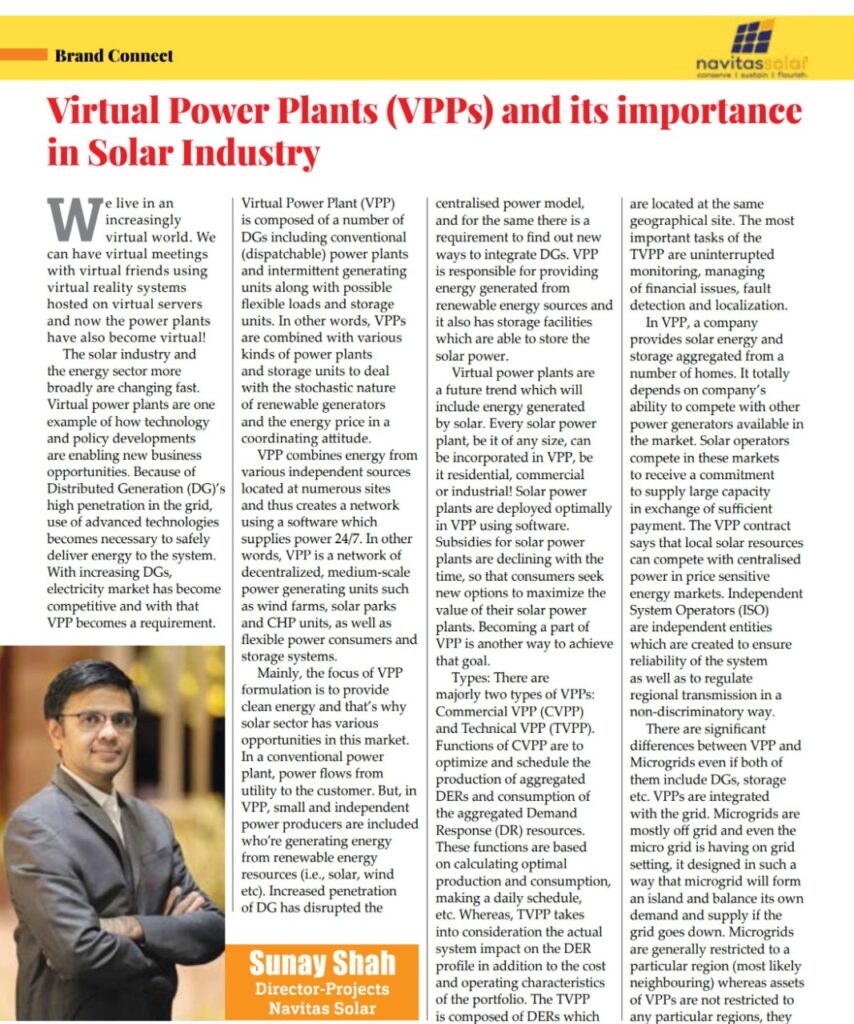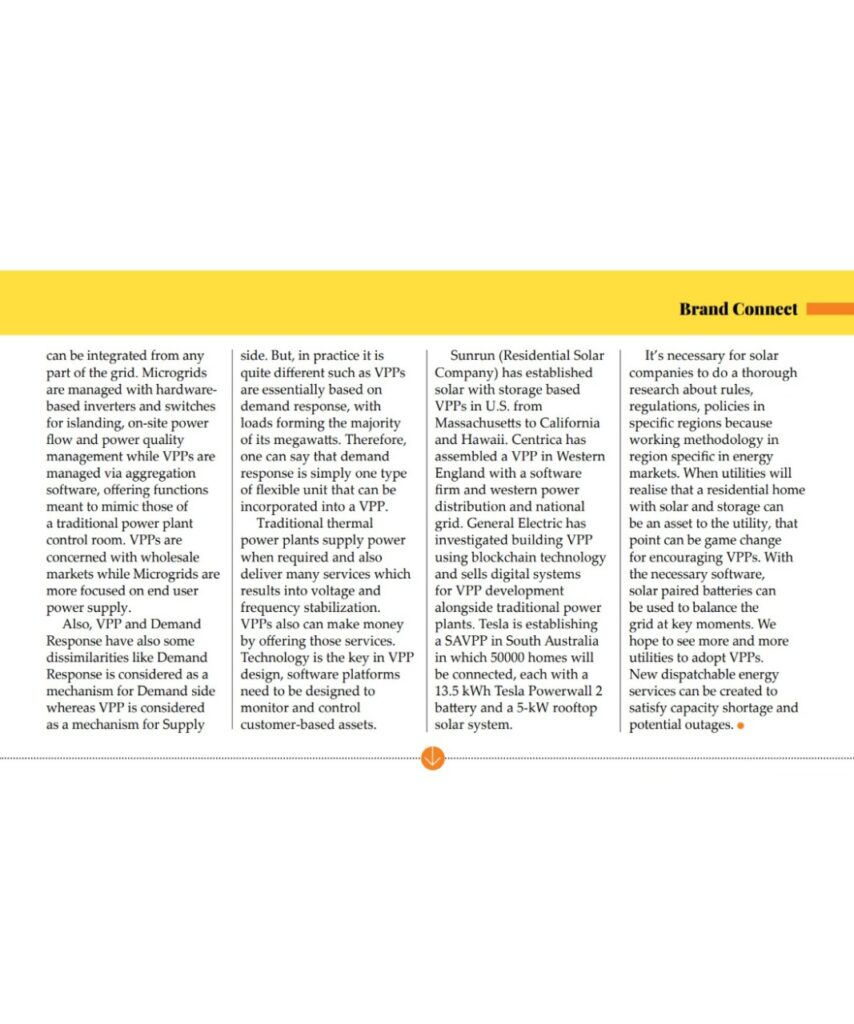Virtual Power Plants: A Vision by Sunay Shah
We live in an increasingly virtual world. We can have virtual meetings with virtual friends using virtual reality systems hosted on virtual servers and now the power plants have also become virtual!
The solar industry and the energy sector more broadly are changing fast. Virtual power plants are one example of how technology and policy developments are enabling new business opportunities. Because of Distributed Generation (DG)’s high penetration in the grid, use of advanced technologies becomes necessary to safely deliver energy to the system. With increasing DGs, electricity market has become competitive and with that VPP becomes a requirement. Virtual Power Plant (VPP) is composed of a number of DGs including conventional (dispatchable) power plants and intermittent generating units along with possible flexible loads and storage units. In other words, VPPs are combined with various kinds of power plants and storage units to deal with the stochastic nature of renewable generators and the energy price in a coordinating attitude.
VPP combines energy from various independent sources located at numerous sites and thus creates a network using a software which supplies power 24/7. In other words, VPP is a network of decentralized, medium-scale power generating units such as wind farms, solar parks and CHP units, as well as flexible power consumers and storage systems.
Mainly, the focus of VPP formulation is to provide clean energy and that’s why solar sector has various opportunities in this market. In a conventional power plant, power flows from utility to the customer. But, in VPP, small and independent power producers are included who’re generating energy from renewable energy resources (i.e., solar, wind etc). Increased penetration of DG has disrupted the centralized power model, and for the same there is a requirement to find out new ways to integrate DGs. VPP is responsible for providing energy generated from renewable energy sources and it also has storage facilities which are able to store the solar power.
Virtual power plants are a future trend which will include energy generated by solar. Every solar power plant, be it of any size, can be incorporated in VPP, be it residential, commercial or industrial! Solar power plants are deployed optimally in VPP using software. Subsidies for solar power plants are declining with the time, so that consumers seek new options to maximize the value of their solar power plants. Becoming a part of VPP is another way to achieve that goal.
Types: There are majorly two types of VPPs: Commercial VPP (CVPP) and Technical VPP (TVPP). Functions of CVPP are to optimize and schedule the production of aggregated DERs and consumption of the aggregated Demand Response (DR) resources. These functions are based on calculating optimal production and consumption, making a daily schedule, etc. Whereas, TVPP takes into consideration the actual system impact on the DER profile in addition to the cost and operating characteristics of the portfolio. The TVPP is composed of DERs which are located at the same geographical site. The most important tasks of the TVPP are uninterrupted monitoring, managing of financial issues, fault detection and localization.
In VPP, a company provides solar energy and storage aggregated from a number of homes. It totally depends on company’s ability to compete with other power generators available in the market. Solar operators compete in these markets to receive a commitment to supply large capacity in exchange of sufficient payment. The VPP contract says that local solar resources can compete with centralized power in price sensitive energy markets. Independent System Operators (ISO) are independent entities which are created to ensure reliability of the system as well as to regulate regional transmission in a non-discriminatory way.
There are significant differences between VPP and Microgrids even if both of them include DGs, storage etc. VPPs are integrated with the grid. Microgrids are mostly off grid and even the micro grid is having on grid setting, it designed in such a way that microgrid will form an island and balance its own demand and supply if the grid goes down. Microgrids are generally restricted to a particular region (most likely neighboring) whereas assets of VPPs are not restricted to any particular regions, they can be integrated from any part of the grid. Microgrids are managed with hardware-based inverters and switches for islanding, on-site power flow and power quality management while VPPs are managed via aggregation software, offering functions meant to mimic those of a traditional power plant control room. VPPs are concerned with wholesale markets while Microgrids are more focused on end user power supply.
Also, VPP and Demand Response have also some dissimilarities like Demand Response is considered as a mechanism for Demand side whereas VPP is considered as a mechanism for Supply side. But, in practice it is quite different such as VPPs are essentially based on demand response, with loads forming the majority of its megawatts. Therefore, one can say that demand response is simply one type of flexible unit that can be incorporated into a VPP.
Traditional thermal power plants supply power when required and also deliver many services which results into voltage and frequency stabilization. VPPs also can make money by offering those services. Technology is the key in VPP design, software platforms need to be designed to monitor and control customer-based assets.
Sunrun (Residential Solar Company) has established solar with storage based VPPs in U.S. from Massachusetts to California and Hawaii. Centrica has assembled a VPP in Western England with a software firm and western power distribution and national grid. General Electric has investigated building VPP using blockchain technology and sells digital systems for VPP development alongside traditional power plants. Tesla is establishing a SAVPP in South Australia in which 50000 homes will be connected, each with a 13.5 kWh Tesla Powerwall 2 battery and a 5-kW rooftop solar system.
It’s necessary for solar companies to do a thorough research about rules, regulations, policies in specific regions because working methodology in region specific in energy markets. When utilities will realise that a residential home with solar and storage can be an asset to the utility, that point can be game change for encouraging VPPs. With the necessary software, solar paired batteries can be used to balance the grid at key moments. We hope to see more and more utilities to adopt VPPs. New dispatchable energy services can be created to satisfy capacity shortage and potential outages.




 Online | Privacy policy
Online | Privacy policy
Related Posts
You May Also Like
Bonito Series: Driving Innovation in…
Read MoreTOPCon Series: The Next Generation…
Read MoreValuable Points to Remember During…
Read MoreNavitas Planet Partners with Hysolwin…
Read MoreDriving Towards a Sustainable Future:…
Read MoreWhy Do Top-Grade EVA Sheets…
Read MoreBonito Series: Driving Innovation in…
Read MoreTOPCon Series: The Next Generation…
Read MoreValuable Points to Remember During…
Read MoreNavitas Planet Partners with Hysolwin…
Read MoreDriving Towards a Sustainable Future:…
Read MoreWhy Do Top-Grade EVA Sheets…
Read MoreBonito Series: Driving Innovation in…
Read MoreTOPCon Series: The Next Generation…
Read MoreValuable Points to Remember During…
Read MoreNavitas Planet Partners with Hysolwin…
Read More